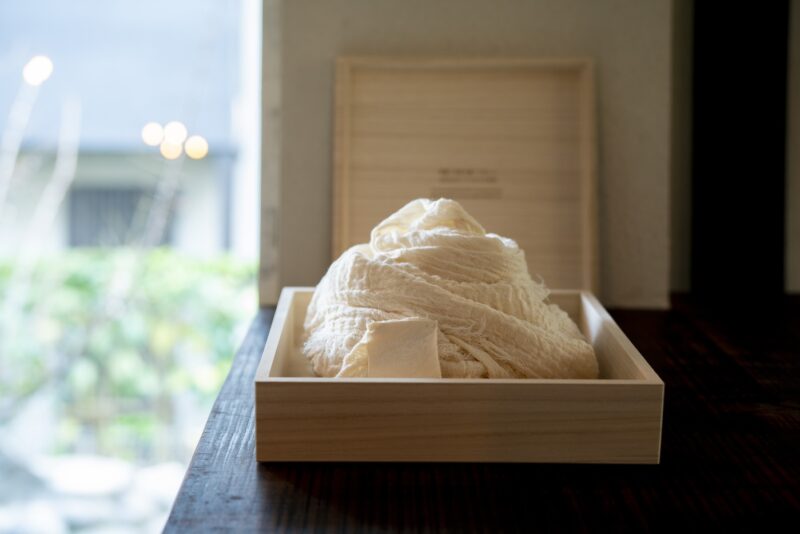niime 百科
Encyclopedia of niime
tamaki niime okurimon
古都鎌倉から全世界へと届ける贈りもの。
tamaki niime okurimon
The gifts from the former capital of Kamakura to the world
古都鎌倉から全世界へと届ける贈りもの。
The gifts from the former capital of Kamakura to the world

2024 . 07 . 30
“地球を贈ろう。 鎌倉から世界へ”
2024.4.1。日本の古都・鎌倉。常に変化を繰り返し唯一無二の創造を追求し続けるブランドtamaki niimeによる一点モノのモノづくり、その新たな進化形である「純粋な国産」を表現し伝える場が誕生した。
その名も「tamaki niime okurimon」。
先染め織物・播州織産地の中心である“日本のへそ”西脇市に腰を据え、大量生産の時代に分業化が進んだ生産工程を自前のLabに集約、それらすべてを自分たちの目と手で検証し、従来の方法論にこだわらない、自由でかつ独自のアプローチで播州織を新解釈したtamaki niime。
産地に移住するのみならず織物職人に教えを請い、デザイナー自らが手を動かし機を織る。畑に種を蒔き、布の原材料であるコットンの栽培に着手する。己れの皮膚感覚に貫かれたそのシームレスなクリエーションは、衣食住の根本を見つめ直し、SDGsが叫ばれ始めるるよりも早くから地球の在り方に照らした、新しい時代・新しい暮らしの到来を予感させるものだったと言えるだろう。
ブランド誕生から20年目の節目の年に満を持して、糸をつくる紡績の工程も稼働開始、念願の一貫した内製化の体制が整った。自社の畑で栽培したコットンから原糸を紡ぎ出すことで「染」の工程とリンクし、~「織」~「編み」~「縫製」~「洗い加工」~「販売」~「発信」と、ついにモノづくりの流れがトータルに結びついた。
ひとつひとつの制作工程に心と目を配り、創意工夫を施し、それらを相乗させ、世界に一点だけの作品を産み出してきたtamaki niime。作品の細部に至るあらゆる部分がホームメイド、自前で創り出す純国産のモノづくりがいよいよスタートした。
素材の入手先を海外に頼り自給がおぼつかない日本のモノづくりの現状に強い危機感を持ち、優れた伝統技術を継承し、域内で様々なことが賄えて暮らしと生産が密接に繋がっていたかつての在り方・原点に立ち返り、なおかつ斬新な創造を試みてゆく。
それは既存のモノづくりを捉え直し、既成の概念を超えてゆく、tamaki niimeならではの挑戦だと言えるだろう。
全世界へ向け広くそんな「新たな日本のモノづくり」の発信の地となるのが、歴史と文化が息づく古都・鎌倉。
今回私は4月1日のオープンに合わせ、ヴェールに包まれていた新店舗「okurimon」を直に体感すべく、鎌倉の地を訪れてみることにした。
JR鎌倉駅に着いて江ノ島電鉄(江ノ電)に乗り換える。少し小振りでクリーム色と緑色のツートンカラーが特徴的な4両編成の列車が趣きある古都の街中を縫うように走る。3駅めの長谷駅で降りて改札を出る。沢山の外国人観光客が行き交う目の前の通りを渡って線路沿いの道を歩くとすぐ、正に徒歩1分の立地。「星ノ夜月ノ下」と名付けられた建物の1階に「okurimon」はある。
玉木はじめ睦美や阿江、そして新しいスタッフが迎えてくれた。店長の阿江から店舗の説明を受ける。
亀の甲の紋様がシンボリックに外壁や床にあしらわれているのが先ず印象的だ。それは、一般に“幾何学模様”と称される記号的な意匠ではなく、規則的でありながらも蠢(うご)めく生命体をどこか連想させる。
テーブル、棚、壁、灯り、扉…。選り抜かれた素材に深いインスピレーションを得て人の手を介した造形が有機的に組み合わされ絶妙のバランスで調和する。ひとつひとつに時空を経て此処に集った語り尽くせぬストーリーが内在し、それらの総体が「okurimon」という場を宇宙のように豊かに形成しているのを感じる。
閉じられた空間ではなく、引き戸になった扉は軽やかに開け放たれ屋外の自然の息吹を呼び込む。すりガラスのしつらえも細やかに、ディテールをつぶさに観ると手の業(わざ)の温かみがそこかしこに宿っている。
あらかじめの設計図などは用意されず、杓子定規ではない、手描きのスケッチをもとに、施工が成されているのだという。
緩やかな曲線を描く一枚板2枚が組み合わさったテーブル。表面に引かれたスクラッチのような無数の線は織機に並ぶ経糸をイメージしたものだそう。テーブルの台の側面には亀の甲模様が刻まれている。創りながらその場その時の感性を働かせて定着させる。その手法は生の営みの証のようだ。
珪藻土の壁に入ったひび割れをあえてその上に自在な線を描き補修を施す。あたかも珪藻土のマチエールの上にドローイングするように。
その壁から生え出たようにひとつひとつが異なるフォルムの棚に、tamaki niimeの作品たちが置かれている。
青くペインティングされた雄鹿のスカル。天井を這う蔓(つる)と葉はよく目を凝らすと鉄製なのだがまるで自然物のような質感を湛えて伸びやかに空間を彩る。その蔓と交感するようにショールが掛かっている。
一番奥の棚の上には、ショールに加えてセーター、ジーンズなどが。それらtamaki niimeによる「純粋な国産」作品たちに添えられた小さな布片には、原材料の「綿」づくりから「紡績」「染色」「整経」「製織」「ネームタグ」「デザイン」「洗い」…等々、tamaki niimeを中心に工程に関わったすべての社名が誇り高く印字されている。
「okurimon」の店舗となる空間を、想いを込めて創造したのは地元鎌倉に根差し建築を手掛ける「team kamakura」。
「出来た瞬間が建築の完成ではない。この空間はここから熟成が始まる。その熟成さえもが建築。」
「team kamakura」代表の言葉である。
オープン時が完成形であってあとは古びてゆくのみではない、人が介在し周囲の自然環境と交歓しながら成長・成熟してゆく、従来の建築の概念を一変させてしまうような店舗空間。その在り方はまるでしなやかな生きもののようだ。
「okurimon」とは、tamaki niimeの作品たちと拮抗しながら高次元で親和する、特別に設られた器なのかもしれない。即興も活き活きと取り入れながら、まるで命ある存在のようにフレキシブルなこの空間の生成過程は、tamaki niimeの創作と驚くほど似ている。
遊び心と仕掛け、柔軟さ、偶然性、驚き…そして美しく、唯一無二であること。
世界に誇れる日本の播州織。その新たな可能性を体現するtamaki niimeのモノづくり、その中でも純度100%の国産作品を展示し販売する場として、ブランドに内在するポテンシャルを十全に引き出すための舞台として、正に相応しい空間だと感じる。
古都・鎌倉の街並は独特だ。
開け放たれた引き戸のすぐそばをコトコトと「江ノ電」の電車が往来する。開放感と解放感。距離の近しさ。
観光客で賑わう鎌倉大仏、長谷寺。その喧騒とは対照的にもっとも古い社殿であるという甘縄神明宮の密やかな佇まい。鎌倉のまちには底知れない奥深さがある。
寺社をはじめ貴重な歴史遺産や緑豊かな山と美しい浜辺に恵まれた自然環境、長年に渡って醸成された風雅な街並みが揃う鎌倉。日本における市民によるナショナルトラスト運動の発祥の地であり、市街地全域が景観計画区域に指定されてもいる。
三方を豊かな森に囲まれ穏やかな浜辺から果てしない海へと開かれたまちー。
「okurimon」から由比ヶ浜まではほんの数分。緩やかな弓状の浜辺に寄せては返す波。その波は太平洋を経て世界へと届く。
古都・鎌倉に届く波動を感じ取りながら、新次元のtamaki niimeが始動する。
日本文化の粋を今に遺し、世界各国から人を呼び込むこの地は全世界へ向け「純粋な国産」のモノづくりを発信するにふさわしい、地球とtamaki niimeの接点なのだ。そう実感した私だった。
“地球を贈ろう。 鎌倉から世界へ”
ぜひ鎌倉を訪れて、まちと自然と歴史と、「okurimon」の空間とtamaki niimeの作品たち、すべてが、相互に・親密に作用し合う、稀有な場を直に体感していただきたい。
書き人越川誠司
“Let’s send the gift of earth from Kamakura to the world.”
On April 1st, 2024, in Kamakura, the ancient capital of Japan. The brand ‘tamaki niime’ has been pursuing only one item creation while constantly repeating to make changes. They have produced new evolutionary products to express the ‘purely made in Japan’ concept and finally have a place to show them.
The name is ‘tamaki niime okurimon’.
They are stationed in Nishiwaki, the ‘Navel of Japan’, the centre of the yarn-dyed fabric of Banshu ori’s birthplace. In the time of mass production with the process of division of labour, ‘tamaki niime’ set up all the equipment in the factory for all the processes, and they checked them with their own eyes and hands. They got their free approach for the Banshu ori, which doesn’t stick to traditional methods.
Not only did they choose to live in the Banshu ori birthplace, but they even asked weaving experts to learn, and the designer weaved with her own hands. They started sowing the seeds of cotton, the original cloth material, on the fields and growing them. In creating seamless products, they reassessed our basic lifestyle of clothing, eating, and housing, which predicted the coming of a new era and new living styles, focusing on how the earth should be, even earlier before the world started talking about SDGs.
On the 20th anniversary of the brand’s birth, they started the spinning process to make thread. Their dream finally came true, and a consistent house production was established. They weave the original threads with the cotton that they grow on their own cotton fields so that they connect with the processes of ‘dye’, ‘weaving’, ‘sewing’, ‘washing process’, ‘sales’, and ‘advertising’. They finally completed all total manufacturing processes.
Focusing on each manufacturing process with their hearts and eyes, coming up with creation ideas and utilizing both advantages, they came to create the products of the only one in the world. All parts of the products, including the little details, are homemade, and they finally started their own creation with pure Japanese materials.
They have a strong sense of crisis in depending on imports of foreign materials and being unable to support themselves, which is the reality of Japanese manufacturing; that’s why they inherit excellent traditional skills and reflect the past and origins that they used to many things within the region and had tight connections with living and production. They even try to create innovative creations.
They rethink present manufacturing, overcoming original ideas. That would be the challenge that only ‘tamaki niime’ can do.
For the whole world, Kamakura is the birthplace of ‘new Japanese manufacturing’, an ancient capital bursting with history and culture.
Expecting the store to open on April 1st, I visited Kamakura to see a new store veiled in mystery and to experience the store ‘Okurimon’.
I got off the train at JR Kamakura station. I transferred to the Enoshima Dentetsu line, which is characteristic of two-tone light yellow and green colours and a small 4 track train running like sewing around the quaint city. I got off at the third station, Hase station, and exited the ticket gate. Crossing in front of the street, many foreign travellers are walking. Here, it is only one minute’s distance, and there’s the store ‘Okurimon’ in the building named ‘Starry Night, Under Moon’.
Ms Tamaki, Mutsumi, Ms Ae, and other new staff members welcomed me. The store manager, Ms Ae, explained the store to me.
Seeing the tortoiseshell pattern on the outside walls and floors was impressive. Although they are not geometric patterns like symbols, they make you think of writhing life forms even though they are regular.
Tables, shelves, walls, lights, and doors are made of selective materials with deep inspiration, made by people’s hands, and perfectly balanced in harmony. Each one has been gathered here over time and has an unspoken story. I feel ‘Okurimon’ is richly formed overall, like the universe.
It was not a closed space, but the sliding doors opened easily and brought in outside air. Frosted glasses were also carefully arranged. When I saw the details, I could feel the warmth of people’s hands everywhere.
They didn’t have a planned blueprint, no standard rules, and built with handwritten sketches and got it done.
There is a table made from two gently curved pieces of wood. Many lines that look like scratches on the surface have images of thread displays on the weaving machines. A turtle shell pattern is applied to the sides of the table. While creating, they work with inspiration one by one. That technique looks like the testimony of authentic works.
They drew the line freely to fix cracks on the wall made with diatomaceous dirt, and they looked like they were enjoying drawing on the material of diatomaceous dirt.
Like the ones from that wall, each is a different shelf, and the ‘tamaki niime’ products are displayed on it.
The male deer’s skull is painted in blue. Watching the vines and leaves carefully, they were made of iron, but they looked natural and made the space colourful. As if exchanging vines, shawls are hanged.
In addition to the shawls on the back shelves, sweaters and jeans are placed. In the small cloth tags with ‘purely made in Japan products’, the company names which worked in the processes with ‘tamaki niime’ are proudly printed; such processes are kinds of cotton of original materials, weaving, dyes, warper, name tagging, designs, wash, and…etc.
The store ‘Okurimon’ was created with hearts by ‘team Kamakura’ rooted in local Kamakura to work with architecture.
The moment of finishing is not the completion of the architect. Such space starts to develop from that point, and even such developments include an architect.
Those are the words of the representative of ‘team Kamakura’.
The opening is not in a complete state, and afterwards, it shouldn’t get old. People take action, mingle it with natural surroundings, and make it develop and accomplish. It completely changes the conventional approach to architecture. The existence of the store looks like real living creatures.
‘Okurimon’ might be a special place where the products of ‘tamaki niime’ argue and become friendly at higher dimensions. While incorporating lively improvisation, the developing process of this space, which is like being alive and flexible, surprisingly looks like the creations of ‘tamaki niime’.
They are enjoyable to play, tricks, flexibility, coincidence, surprises… beauty and only one.
Banshu ori is the one we can be proud of in the world. ‘tamaki niime’ challenges more new potential creations. Displaying and selling 100% domestic products, and as it is the right place to show the charms of Banshu ori, it is an appropriate space as the stage to display the brand’s potential.
The streets in the old city of Kamakura are unique.
The Enoden train runs back and forth all day by the opening sliding doors. The sense of openness and feeling of liberation are close feelings to one another.
The Hase Temple is very popular among travellers because of the Kamakura Great Buddha. Compared to its noise, the oldest Amanawa Shinmei Shrine exists quietly. The city of Kamakura has immeasurable depth.
With essential historical heritage like temples and shrines, they are naturally blessed with abundant green mountains and beautiful beaches. The streets of the city of Kamakura have been elegantly made for a long history. It is also the place to start the movement of a national trust. A whole city is reserved as a landscape planning area.
Abundant woods surround the city in three directions, and calm sand beaches open to the endless sea.
It takes just a few minutes from ‘Okurimon’ to Yuigahama Beach. Waves come and go repeatedly along the arched beach. The wave goes out to the world over the Pacific Ocean.
Feeling the waves of the old city, Kamakura, the next dimension of ‘tamaki niime’ is beginning.
Even now, leaving the remnants of Japanese culture, this city welcomes many people from all over the world, which is worth sending out manufacturing pure domestic products. I felt it was the connected point of the earth and ‘tamaki niime’.
“Let’s send the gift of earth from Kamakura to the world.”
I would like you to visit Kamakura and have rare experiences that closely interact with the city, nature, and history with the products of ‘tamaki niime’.
Original Japanese text by Seiji Koshikawa.
English translation by Adam & Michiko Whipple.


